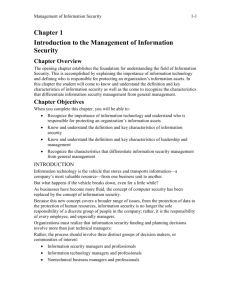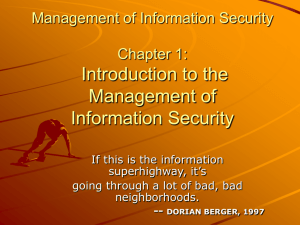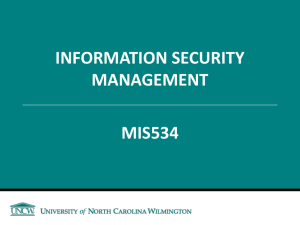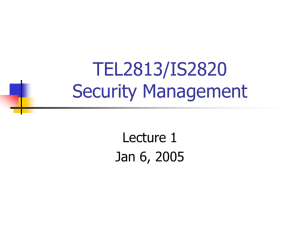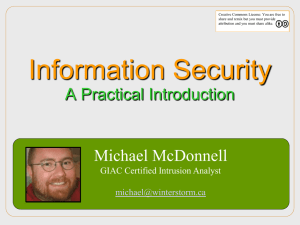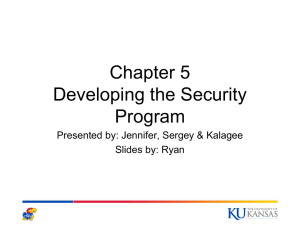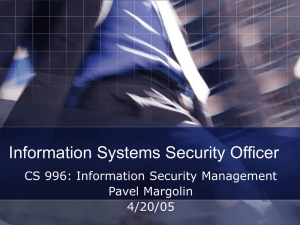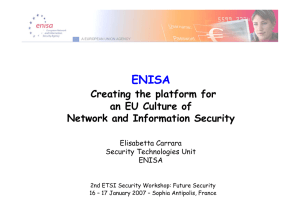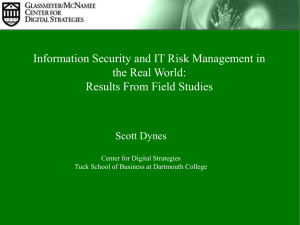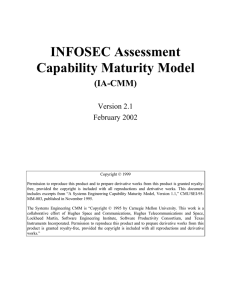TEL2813/IS2820 Security Management
advertisement
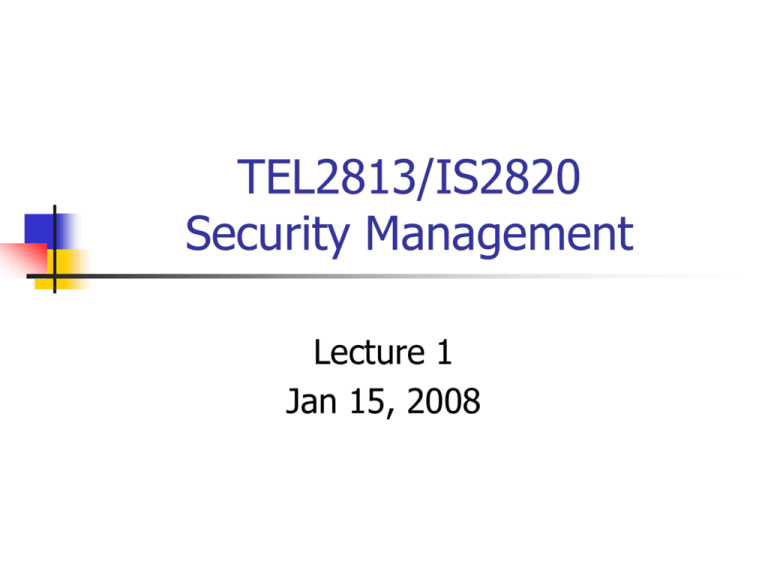
TEL2813/IS2820 Security Management Lecture 1 Jan 15, 2008 Contact James Joshi 706A, IS Building Phone: 412-624-9982 E-mail: jjoshi@mail.sis.pitt.edu Web: http://www.sis.pitt.edu/~lersais/IS2820/Spring07/ Office Hours: Monday: 1.00 – 3.00 p.m. or By appointments GSA: will be announced later Course objective The course is aimed at imparting knowledge and skill sets required to assume the overall responsibilities of administration and management of security of an enterprise information system. Course objective After the course, ability to to carry out detailed analysis of enterprise security by performing various types of analysis vulnerability analysis, penetration testing, audit trail analysis, system and network monitoring, and Configuration management, etc. Carry out the task of security risk management using various practical and theoretical tools. Course objective After the course, ability to carry out Design detailed enterprise wide security plans and policies, and deploy appropriate safeguards (models, mechanisms and tools) at all the levels due consideration to the life-cycle of the enterprise information systems and networks, legal and social environment Be able to certify products according to IA standards (Common Criteria Evaluations) Course content Introduction to Security Management Security policies/models/mechanisms Security Management Principles, Models and Practices Security Planning/ Asset Protection Security Programs and Disaster Recovery Plans Security Analysis and Safeguards Vulnerability analysis (Tools & Tech.) Penetration testing Risk Management Protection Mechanisms and Incident handling Standards and Security Certification Issues Rainbow Series, Common Criteria Security Certification Process National/International Security Laws and Ethical Issues Access Control and Authentication architecture Configuration Management Auditing systems audit trail analysis Network defense and countermeasures Intrusion Detection Systems (SNORT) Architectural configurations Firewall configurations Virtual private networks Computer and network forensic Privacy Protection Case studies Lab exercises Course Material Recommended course material Management of Information Security, M. E. Whitman, H. J. Mattord Guide to Disaster Recovery, M. Erbschilde Guide to Network Defense and Countermeasures, G. Holden Real Digital Forensics: Computer Security and Incident Response, 1/e; Keith J. Jones, Richard Bejtlich, Curtis W. Rose Computer Security: Art and Science, Matt Bishop (ISBN: 0-201-44099-7), Addison-Wesley 2003 Security in Computing, 2nd Edition, Charles P. Pfleeger, Prentice Hall Software Security: Building Security In (by Gary McGraw) The Art of Software Security Assessment : Identifying and Preventing Software Vulnerabilities (by Mark Dowd, John McDonald, Justin Schuh) A list of papers and NIST/GAO documents for reading Tentative Grading Assignments (50%) Homework/Quiz/Paper review/Lab (35%) Class Participation/Seminar attendance (5%) 2-3 presentation (10%) Exams 20% Project 30% Course Policies Your work MUST be your own Homework Zero tolerance for cheating/plagiarism You get an F for the course if you cheat in anything however small – NO DISCUSSION Discussing the problem is encouraged Penalty for late assignments (15% each day) Ensure clarity in your answers – no credit will be given for vague answers Homework is primarily the GSA’s responsibility Check webpage for everything! You are responsible for checking the webpage for updates Introduction Introduction Information technology is critical to business and society Computer security is evolving into information security Information security is the responsibility of every member of an organization, but managers play a critical role Introduction Information security involves three distinct communities of interest Information security managers and professionals Information technology managers and professionals Non-technical business managers and professionals Communities of Interest InfoSec community: IT community: protect information assets from threats support business objectives by supplying appropriate information technology Business community: policy and resources What Is Security? “The quality or state of being secure— to be free from danger” Security is achieved using several strategies simultaneously Security and Control Examples Physical security Personal security Operations security Communications security Network security Controls Physical Controls Technical Controls Administrative Prevention – Detection – Recovery Deterrence, Corrective InfoSec Components CIA Triangle The C.I.A. triangle is made up of Confidentiality Integrity Availability Over time the list of characteristics has expanded, but these three remain central CNSS model is based on CIA NSTISSC Security Model (4011) Key Concepts: Confidentiality Confidentiality only those with sufficient privileges may access certain information Confidentiality model Some threats Bell-LaPadula No write down & No read up TCSEC/TNI (Orange, Red Book) Hackers Masqueraders Unauthorized users Unprotected download of files LANS Trojan horses Key Concepts: Integrity Integrity Integrity is the quality or state of being whole, complete, and uncorrupted Integrity model Biba/low water mark Clark-Wilson No write up & No read down Separation of duty Lipner Other issues Origin integrity Data integrity Key Concepts: Availability Availability making information accessible to user access without interference or obstruction Survivability Ensuring availability in presence of attacks Key Concepts: privacy Privacy Information is to be used only for purposes known to the data owner This does not focus on freedom from observation, but rather that information will be used only in ways known to the owner Key Concepts: Identification Identification Information systems possess the characteristic of identification when they are able to recognize individual users Identification and authentication are essential to establishing the level of access or authorization that an individual is granted Key Concepts: Authentication & Authorization Authentication Authentication occurs when a control provides proof that a user possesses the identity that he or she claims Authorization authorization provides assurance that the user has been specifically and explicitly authorized by the proper authority to access the contents of an information asset Key Concepts: Accountability; Assurance Accountability The characteristic of accountability exists when a control provides assurance that every activity undertaken can be attributed to a named person or automated process Assurance Assurance that all security objectives are met What Is Management? A process of achieving objectives using a given set of resources To manage the information security process, first understand core principles of management A manager is “someone who works with and through other people by coordinating their work activities in order to accomplish organizational goals” Managerial Roles Informational role: Collecting, processing, and using information to achieve the objective Interpersonal role: Interacting with superiors, subordinates, outside stakeholders, and other Decisional role: Selecting from alternative approaches and resolving conflicts, dilemmas, or challenges Differences Between Leadership and Management The leader influences employees so that they are willing to accomplish objectives He or she is expected to lead by example and demonstrate personal traits that instill a desire in others to follow Leadership provides purpose, direction, and motivation to those that follow A manager administers the resources of the organization, budgets, authorizes expenditure Characteristics of a Leader 1. 2. 3. 4. 5. 6. 7. Bearing Courage Decisiveness Dependability Endurance Enthusiasm Initiative Used by US military 8. 9. 10. 11. 12. 13. 14. Integrity Judgment Justice Knowledge Loyalty Tact Unselfishness What Makes a Good Leader? Action plan 1. 2. 3. 4. 5. 6. Know yourself and seek self-improvement Be technically and tactically proficient Seek responsibility and take responsibility for your actions Make sound and timely decisions Set the example Know your [subordinates] and look out for their wellbeing 7. 8. 9. 10. 11. Keep your subordinates informed Develop a sense of responsibility in your subordinates Ensure the task is understood, supervised, and accomplished Build the team Employ your team in accordance with its capabilities Leadership quality and types A leader must: BE a person of strong and honorable character KNOW you, the details of your situation, the standards to which you work, human nature, and your team DO by providing purpose, direction, and motivation to your team Three basic behavioral types of leaders: Autocratic Democratic Laissez-faire Characteristics of Management Two well-known approaches to management: Traditional management theory using principles of planning, organizing, staffing, directing, and controlling (POSDC) Popular management theory using principles of management into planning, organizing, leading, and controlling (POLC) The Planning–Controlling Link Planning & Organization Planning: process that develops, creates, and implements strategies for the accomplishment of objectives Three levels of planning Strategic Tactical Operational • Organization: structuring of resources to support the accomplishment of objectives Leadership Encourages the implementation of the planning and organizing functions, Includes supervising employee behavior, performance, attendance, and attitude Leadership generally addresses the direction and motivation of the human resource Control Control: Monitoring progress toward completion Making necessary adjustments to achieve the desired objectives Controlling function determines what must be monitored as well as using specific control tools to gather and evaluate information Control Tools Four categories: Information Financial Guide use of monetary resources (ROI,CBA,..) Operational Information flows/ communications PERT, Gantt, process flow Behavioral Human resources The Control Process Solving Problems Step 1: Recognize and Define the Problem Step 2: Gather Facts and Make Assumptions Step 3: Develop Possible Solutions (Brainstorming) Step 4: Analyze and Compare the Possible Solutions (Feasibility analysis) Step 5: Select, Implement, and Evaluate a Solution Feasibility Analyses Economic feasibility assesses costs and benefits of a solution Technological feasibility assesses an organization’s ability to acquire and manage a solution Behavioral feasibility assesses whether members of the organization will support a solution Operational feasibility assesses if an organization can integrate a solution Principles Of Information Security Management The extended characteristics of information security are known as the six Ps: Planning Policy Programs Protection People Project Management InfoSec Planning Planning as part of InfoSec management is an extension of the basic planning model discussed earlier Included in the InfoSec planning model are activities necessary to support the design, creation, and implementation of information security strategies as they exist within the IT planning environment InfoSec Planning Types Several types of InfoSec plans exist: Incident response Business continuity Disaster recovery Policy Personnel Technology rollout Risk management and Security program including education, training and awareness Policy Policy: set of organizational guidelines that dictates certain behavior within the organization In InfoSec, there are three general categories of policy: General program policy (Enterprise Security Policy) An issue-specific security policy (ISSP) E.g., email, Intenert use System-specific policies (SSSPs) E.g., Access control list (ACLs) for a device Programs Programs are operations managed as specific entities in the information security domain Example: A security education training and awareness (SETA) program is one such entity Other programs that may emerge include a physical security program, complete with fire, physical access, gates, guards, and so on Protection Risk management activities, including risk assessment and control, & Protection mechanisms, technologies & tools Each of these mechanisms represents some aspect of the management of specific controls in the overall security plan People People are the most critical link in the information security program Human firewall It is imperative that managers continuously recognize the crucial role that people play; includes information security personnel and the security of personnel, as well as aspects of the SETA program Project Management Project management discipline should be present throughout all elements of the information security program Involves Identifying and controlling the resources applied to the project Measuring progress and adjusting the process as progress is made toward the goal
